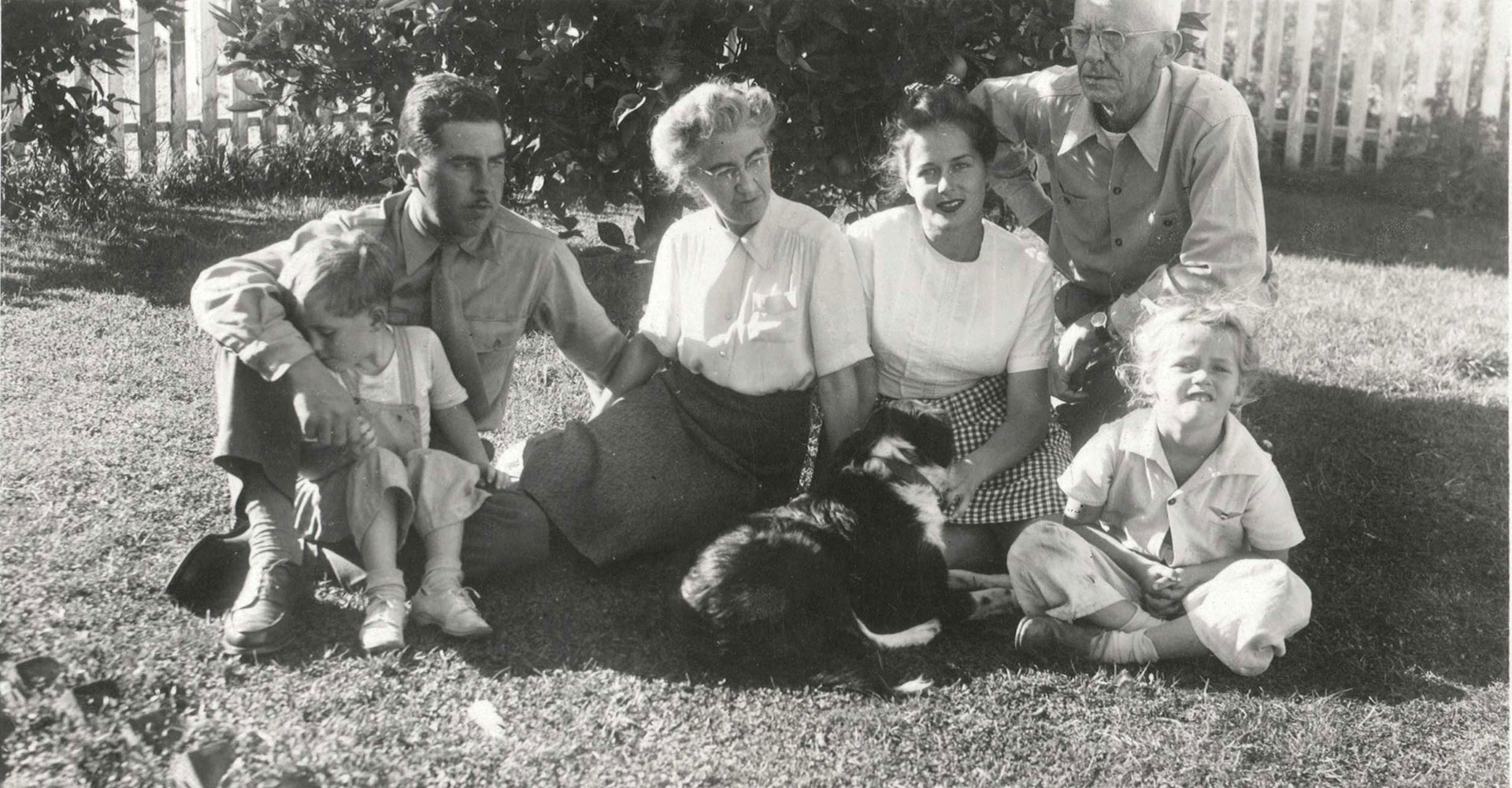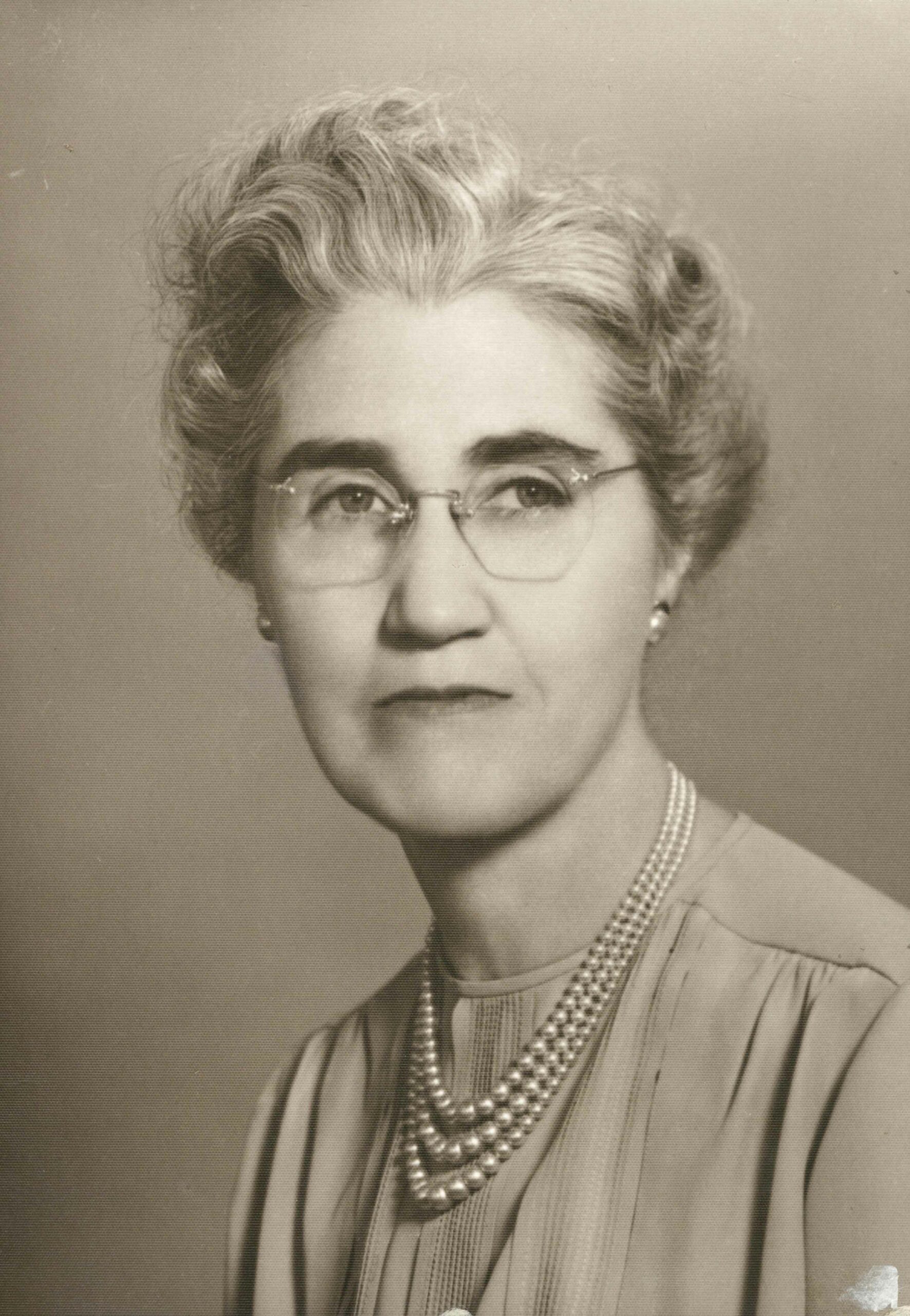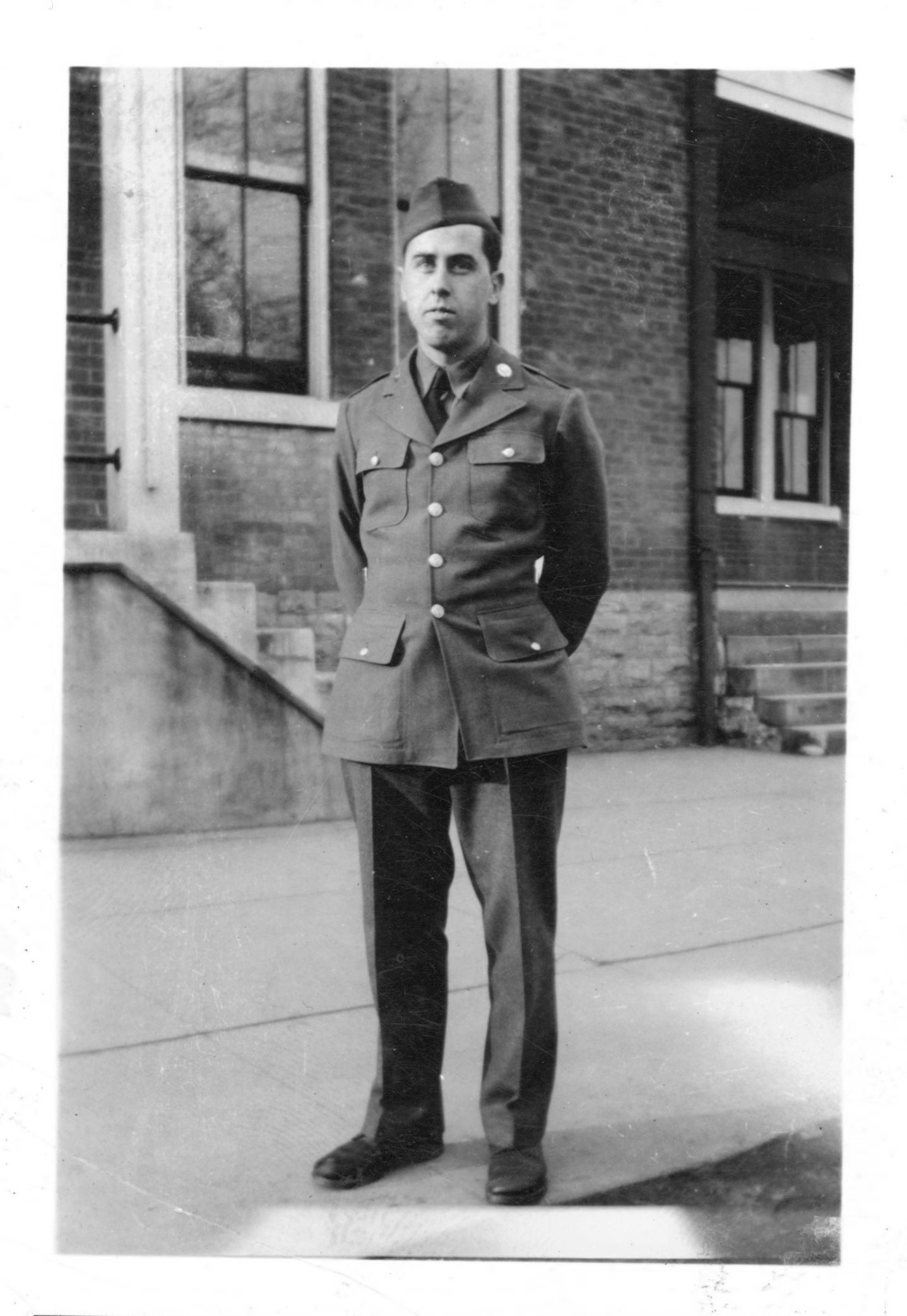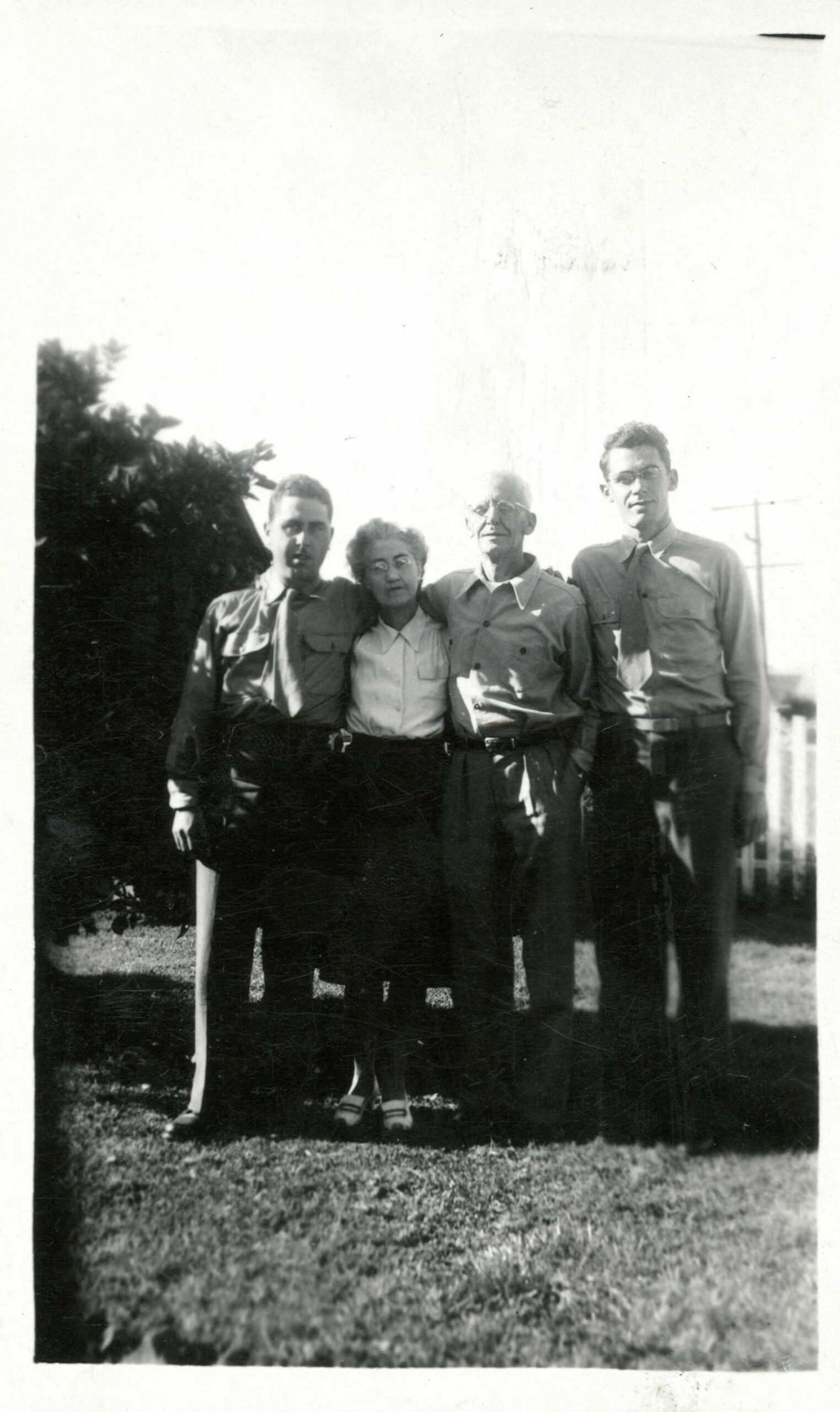
Sewing Lessons
Shelley Johansson shares the story of how sewing has sustained the women of her family for almost a century — from bandages during World War II to masks for the current pandemic.
Beside my living room couch, a maple sewing box sits on spindle legs. Topped by a handle, the box has hinged doors that swing upward to reveal a good-sized cavity under a removable sliding tray for thread, needles and other sundries. This unassuming piece has a grace and practicality I’ve always appreciated. Aesthetics aside, it is an heirloom. My great-uncle, Bob Dietrich, built the sewing box in a high school shop class for his mother, Eva, my great-grandmother, in the late 1930s.
The Dietrich family was then living in Louisville, Kentucky, and Bob was working in his father’s residential construction business. When World War II hit, Bob was drafted and trained as a radioman with the Army’s 192 Tank Battalion Company D, and was sent to the Philippines in November 1941. Fighting was brutal through the first months of 1942, and the Allied forces were ultimately unable to withstand the onslaught. “Fall of Bataan,” Eva noted tersely in her diary on Apr. 9, 1942, and Japan took control of the Philippines.
On August 1, Eva notes, “Had a letter from Bob, written Mar. 1 [before Bataan’s fall]. Heard mail bag was found floating in the Pacific.” On August 11, “Received Bob’s watch back that we sent him for Christmas.” On October 12, “A whole year has passed since Bob left home.” As her diaries reveal, for 14 long months the Dietrich family had no idea if Bob had survived the battle and its aftermath, which would include the Bataan Death March.
~~~

Eva’s diaries, along with a handful of surviving letters, were passed on to my mother, her oldest grandchild. The diaries are of that once popular “Five-Year Diary” type, where each page features the month and day, along with table-like grids creating small spaces to record the events of that date for five consecutive years. The format separates you from her story, as your eye tends to scan five years down the page, rather than day to day, left to right. She began keeping them in 1941, when she was in her early 50s – the same age I am now. Although she doesn’t explicitly say why, it’s clear she wanted to record her experiences during a monumental time in history.
Eva was not one to express much emotion in her diaries, or in life by all accounts. Her diary entries are brief, almost curt. Staccato sentences document what happened but seldom how she felt about it. She was into statistics – when grandchildren (and later, great-grandchildren – including me) were born she’d record the baby’s name, weight, and exact birth time and nothing else. She kept lists of minutiae like football bowl scores and the names of friends for whom she had ordered gift subscriptions to the Saturday Evening Post and Ladies Home Journal. Truth be told, the diaries mostly make for deadly dull reading.
One activity Eva records throughout her life is sewing. During World War II she hand-sewed thousands of surgical bandages and dressings for the Red Cross. She also documents many instances of sewing for herself and family during the war years, making clothes, “a warm nighty,” mending, remodeling old garments in an effort to be thrifty and help the war effort. I picture her sitting straight-backed at her sewing machine, needle flying, glancing at the sewing box her son made and willing him to survive.
In those days, of course, you could save money by making clothes rather than buying them — sewing was a necessary skill, and a Singer sewing machine was standard household equipment. By 1977, when my mother inherited the sewing box, this was changing rapidly. Today, it is just not possible to sew clothing cheaper than you can buy it ready-made.
For me, sewing is an expensive, albeit treasured, hobby. I make quilts, wall hangings, decorative pillows, bags, pouches, and other items that have some use, but their main purpose is to be beautiful. My guest room doubles as my sewing room, and I own two sewing machines — one a multi-stitch domestic with a computerized motor, one a straight stitch semi-industrial with a powerful all-metal motor that can punch through many thicknesses of fabric, batting, interfacing and foam. I keep notebooks of patterns, drawers full of sewing notions, a large rack of thread and bobbins in every color imaginable, a collection of more than 200 zippers in different colors and lengths, bolts of interfacing in various weights, and stacks of gorgeous cotton fabric.
But until March 2020, when I started sewing dozens of face masks in response to the coronavirus pandemic, I had never made anything purely for utility’s sake – or anything remotely approaching a garment.
~~~

On Jun. 22, 1943, Eva’s diary reflects a rare burst of feeling: “telegram from War Dept. saying Bob a POW of the Japanese. Great rejoicing.” Bob was alive! The first direct communication arrived on August 11: “Card from Bob today. Well & uninjured. Happy day,” she wrote. The family patriarch, Joe, wrote back to his son the same day, and the newsy letter survives: “We are so glad to know that you are uninjured and in good health. You must stay that way,” he wrote. “I still have your car and hope to be able to give you a new one when you come back.”
But communication from Bob was rare, and the worry had to be excruciating, even if Eva doesn’t say so directly: “Japanese atrocities towards prisoners in P.I. [Philippine Islands] revealed, especially at Camp #1 where Bob was confined,” she wrote on Jan. 2, 1944.
Joe became increasingly despondent about his son’s fate, and was often found weeping quietly. Together, the family decided that Eva and Joe should move to Los Angeles to live with their younger son, Bill, and his wife Bette – my grandparents. Daughter Marie and her new husband would remain in the family house in Louisville, where they would receive any important communications about Bob from the War Department. In February 1944, the day after hosting Marie’s wedding luncheon, my great-grandparents set off on the journey, diary carefully packed. Eva was impressed: “saw Grand Canyon. Wonderful sight. Drove through most desert land and around more mtns. than ever before.”
Bill, who also had experience in his father’s construction business, had built the Los Angeles house for his family – which by now included my mother, Betti, and baby Joe – at a cost of $1,600. The family story is that his carpentry skills got him a job working on the Spruce Goose, a massive, wooden transport aircraft that was the pet project of the eccentric millionaire Howard Hughes. According to the story, Bill worked on the plane for a couple days, concluded it wouldn’t fly, and made an appointment with Hughes to quit and tell him the project was a boondoggle. Whether my grandfather actually talked to Hughes is unclear, but when my grandmother died in 2010 her papers included an uncashed check for $4.50 dated Apr. 13, 1944 from the Hughes Aircraft Company, confirming part of the tale. That my Papaw kept the check as a souvenir rather than buying a week’s worth of groceries is typical of his sly sense of humor, and today it hangs in a frame on my kitchen wall.
~~~
About a month into the pandemic my mom mentioned my great-grandmother’s World War II bandage-making in the context of my own coronavirus sewing, which by then had expanded from face masks to dozens of surgical caps for nurses working in the local hospital’s COVID wards. I honestly hadn’t thought of that parallel – maybe because there is no gauzy story of sewing skills being passed through the generations. While Eva clearly liked sewing, her daughter-in-law (and my beloved grandmother), Bette, found it a necessary evil – there are plenty of funny family stories about my Nana’s slapdash sewing skills, and the imperfect garments she made that the kids had to wear.
So my mother didn’t learn to sew from her mother or grandmother, but rather in a high school home economics class. Unlike my Nana, she enjoyed it, making clothes for me and my sister when we were little – so many, in fact, that a cherished family story is that as a toddler I was confused when my mother presented me with a new dress she’d bought – “dresses have TAGS?” I asked.
As for me, I learned a bit of sewing from my mom, but I didn’t get serious about it until I was in my early 30s, when I was looking for an artistic hobby and my friends began having babies. I wanted to make gifts for my friends’ children that would be kept and treasured – so I taught myself to quilt, and my mother passed Eva’s sewing box down to me. But my 18-year-old daughter has no interest in sewing at all.
~~~

On Oct. 12, 1944, Eva wrote, “Felt rather low today. Another year gone by and no word from Bob since Dec. Still hopeful.” Desperate to help the war effort, Joe attempted to join the armed services, figuring he could talk to every soldier he met to seek news about his son, but was refused because of his age. Undaunted, he joined the Merchant Marine as chief cook, having worked in restaurants most of his life before becoming a builder.
Joe too kept a diary during his first two tours at sea, using an empty bank book for the purpose. Although most entries are brief, he writes more evocatively than his wife. “Busy as hell. Baker under the weather, too much liquor,” an early entry reads, just after he left for his first tour aboard the Liberty freighter Jos. J. Kinyoun, which sailed through the Pacific to New Guinea. He shows occasional flashes of humor: “Crossed Int. Date Line Dec. 17 – my birthday. Had 2 Sundays and 2 birthdays, 60 and 61 years. Aging rapidly.”
Joe embarked on another tour, this time aboard the SS Cape Saunders, in January 1945. “Sailed bound for India. Sorry I didn’t get a trip to Philippines. Wanted to be there when American prisoners were liberated. Hoping against hope that Bob would be among them,” he wrote on January 25.
Eva was thinking along the same lines: “First reports of prisoners rescued at Cabantuan [Philippines]. 510 in all. Rain. Finished baby dress and comfort,” she wrote on February 1, just after Marie’s first daughter was born. No emotion expressed, but she had to have been hoping with every fiber of her being. The next day, “Went to Westwood in rain to mail package to baby and go to Red Cross to inquire about prisoner list.” But on February 3, hopes were dashed: “Bob transferred to Japan. Wrote to Marie and Dad [Joe].”
Joe, far away at sea, got the crushing news from his wife’s letter. “I was almost prepared to learn that Bob was not one of the rescued prisoners, but it reduced my morale to a new low. I suspected he had been moved to Japan. But I will not give up hope that at the end of this war he will return to us,” he wrote on March 13, docked in Kolkata, India.
~~~
To make a coronavirus mask, you cut a rectangle of fabric, 14” x 8”, which is easy using a quilting square and a sharp rotary cutter. I slice through folded fabric to cut many at once – helpful, because after I put out a mask offer on social media, more than 200 friends took me up on it. You fold the rectangle in half, right sides together, and sew the two 8” ends, leaving a slit for turning. Then you sew a 7” length of elastic into each open side to create ear loops, and turn the mask right side out. From there, you set, pin and iron three one-inch pleats and run a seam up the sides to finish.
I’ve followed these simple steps so many times the 7” mark on my rotary cutting mat is worn away from cutting elastic. I can make a mask, start to finish, in six minutes flat. I find mask-making soothing, as it takes so little concentration or skill compared to my other projects. Researchers have found a clear connection between mental well-being and engaging in crafting activities like sewing – the “flow” you get into as you work provides benefits similar to meditation. I also love the feeling that the masks and surgical caps I make will help protect people, that I’m doing something concrete to fight the pandemic.
I know my great-grandmother felt that she was helping the war effort when she sewed bandages – her pride radiates off the page when she notes the exact number she made at a sitting. I’ve learned the history of women making bandages in wartime goes all the way back to the U.S. Sanitary Commission, a Civil War forerunner to the Red Cross. During the Civil War, World War I and World War II, women would collect old bed linens, flour and feed bags, undershirts and other clothing – anything that was uncolored and cotton. They would cut and sew the fabric into long strips to wrap wounds and the limbs of amputees. They would also make 4” x 8” dressings and stuffing for wounds.
Eva often records making hundreds of dressings at a time, so the process had to have been similarly meditative and simple. The repetitive, methodical work – along with the opportunity to be with friends at the Red Cross – must have been a welcome distraction from imagining what her son was experiencing as a POW on the other side of the world.
~~~
On May 7, 1945, Joe wrote, “Germany surrendered today, ending the costliest war of all time in Europe. Should be very happy. Am glad, but not happy. Will have a smaller but bloodier war over here [in Asia], but feel sure we can now end it within a year.” By August 9, the war was rapidly reaching an end: “Repaired some of my dresses. Atomic bomb dropped on Japan,” Eva wrote.
Eva sent Bob a letter on an American Red Cross “Civilian Message Form” on August 19. “On your return to the States we will make plans for the future… I don’t know when Dad [Joe] will be back. Right now he is closer to Japan than to the U.S.,” she wrote. She closes with the most effusive lines I have read from her, in all her diaries and surviving letters: “We are so happy darling Bob that you are coming home. You are in our thoughts and prayers always. Happy birthday Bob.”
The family must have been bursting with impatience for news. “Good news through R.C. [Red Cross] that names of casualties on Fukuoka [Japan] have been released,” Eva wrote on October 3, and finally on October 5: “Telegram from Marie: ‘Bob flown to Philippines on way home.’ I thank Thee dear God.” The former POWs were given the run of the ship’s galley on the journey, and Bob was reunited with his parents and Bill’s family in Los Angeles on November 3. “He looks good,” his mother wrote. “We all talked ’til almost 2 am.” Characteristically, she records nothing about what was said.
Soon all the Dietrichs moved back to Louisville, where Joe, Bill and Bob resumed their construction business as Dietrich & Sons. Bob, who never married, moved with his parents back into the original family home they’d built together, and the three lived there for the rest of their lives. I do have some fleeting memories of family gatherings in that house, which had that distinctive, powdery smell of old people.
My great-grandmother, whom we called Amah, was a spare, bird-like, prim lady who always wore a dress. It was clear she loved watching the great-grandchildren, though she had no idea how to play with us. My great-grandfather, Hapaw, seemed even older to me, as his speech had been affected by a stroke when my mom was a teenager. He died some years before Amah. I remember my great-uncle Bob as a gently rounded, quiet man with horn-rimmed glasses and Brylcreemed hair, glad to be part of the group but always on the periphery.
My favorite thing about the house was the crystal doorknobs so typical of 30s construction, which at eye level looked like giant diamonds. My sister and I entertained ourselves during these family get-togethers by making little notes and drawings for our great-grandparents and Bob and hiding them all over the house -- in the bread box, the linen closet, the pantry, anywhere that wasn’t too private. The men played cribbage at a card table, while the women prepared a meal or played Scrabble in the living room. We kids would make a game of sneaking pieces of butterscotch candy from the china bowl atop the sideboard as the adults pretended not to notice. The next time we would come for a visit, all the little notes and drawings we’d made would be displayed on the door of the old-fashioned refrigerator.
Bob, who weighed less than 100 pounds when he was rescued, told his siblings that the men who were most likely to survive the Bataan Death March and being a POW were those who could best control their emotions. He continued to follow that advice and almost never talked about his experiences, at least not to family members. Much of what we know was relayed by other people – at Bob’s 1985 funeral, a stranger approached my Papaw to share that Bob had saved his life on the death march. The man had been close to collapse from hunger and exhaustion – and men who couldn’t continue were shot on the spot. Bob gave the man a goose’s egg a compassionate Filipino farmer had slipped to him, rather than eating it himself. Papaw couldn’t tell that story without weeping.
~~~
It’s not as if World War II was the only cataclysmic world event Joe and Eva endured over the course of their long lives. Married in 1911, my great-grandfather had tried to enlist during World War I but was refused because of his German heritage. They lost relatives in the 1918 flu epidemic. And when the Depression hit, Joe lost four houses he’d just built on spec, as well as his own family’s. So Joe and Eva moved their four children into a four-room cottage and opened a chicken sandwich stand, eventually saving enough to revive the construction business and build the Louisville family home. Another family story is that during the chicken-stand era Joe became friendly with Harland Sanders, and told him that Kentucky Fried Chicken would never work. Despite this colossally awful business advice, Joe’s restaurant experience would come in handy when he decided to enlist in the Merchant Marine.
“I don’t miss anything about the past. I take things as they come. We have been through great depressions and came through them with flying colors. Of course having the fine husband I had and the fine family I still have, and a sincere faith in God has everything to do with my feelings. I have sewed almost all my life for my family and others and I have made so many choir robes I feel I could supply the Heavenly Choir,” Eva wrote in a 1975 letter.
~~~
I have the Dietrich long face and pronounced chin, wavy hair, and slender bone structure – I’ve always been aware that I look like that side of the family. But I am trying to be like them now, especially the spectacular gallery of strong women stretching back three generations before me: Amah, my great-aunt Marie and Nana, my mom. Like them, I am living through a long, slow catastrophe of unfathomable magnitude, fraught with uncertainty, nowhere near over—and it will be years before we can even begin to understand the depth of its impact, on ourselves and on the world.
“My life is an open book,” Eva wrote in that remarkable 1975 letter. I’m sure she felt that way, although my family has always been disappointed that her diaries provide so little insight into what she felt, that they simply record what she did. But the fact remains that she wrote it down. It was important to her, somehow helpful to her, to create a record of what happened, for herself and for future generations. And she carried on keeping diaries long after the war was over, all the way until her 1977 death. I understand her motivation — what and how I write is very different from my Amah, but why I write is not. And I’ve never been more productive since the pandemic hit, in the sewing room or as a writer. I’ve come to the realization that in this 80-year-old family story, my Amah has left me a clear pattern as to how to survive. So I gently open her sewing box, determined to get on with it.
Shelley Johansson is a native of Nashville who lives, writes and sews in Johnstown, Pennsylvania. Her writing has been featured in Lumiere Review, Prairie Schooner, Rejection Letters, and Schuylkill Valley Journal Online.

